








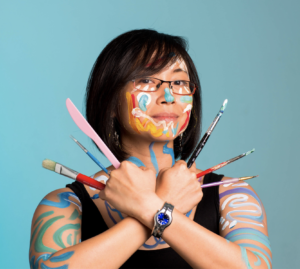
Graphic recorder, Illustrator and Strategic Visualisation Consultant
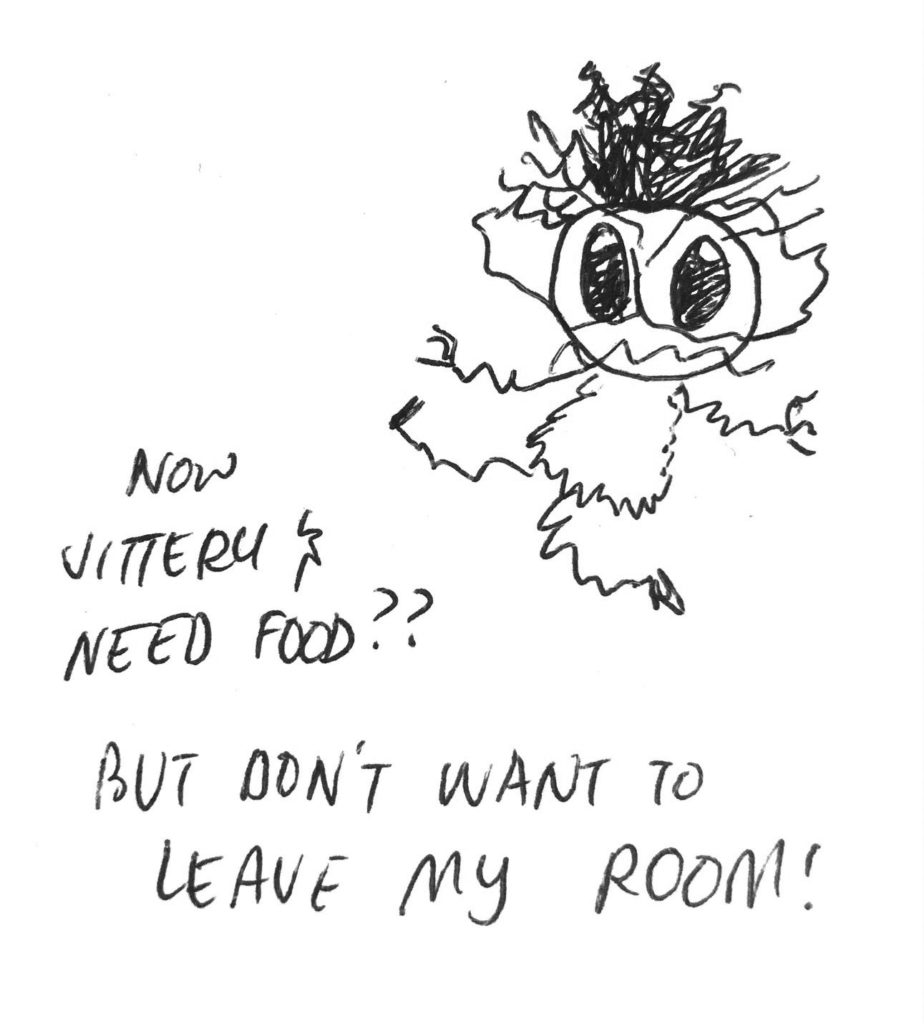
How you are doing now?
I’m doing much better, thank you! I felt pretty depressed at the start of the COVID-19 restrictions in Australia. The mass hoarding behaviour, cancelled projects, family overseas, clouds of gloom and uncertainty – it was a lot, for everyone! But I gave myself time and didn’t guilt myself for it – lots of eating, sleeping and Netflix.
After a few weeks, the sadness lifted and was replaced by a feeling of support. I’m so thankful for local businesses and essential workers that continued to deliver supplies and food. Clients also began to reach out again once the dust settled, and that always feels like magic.
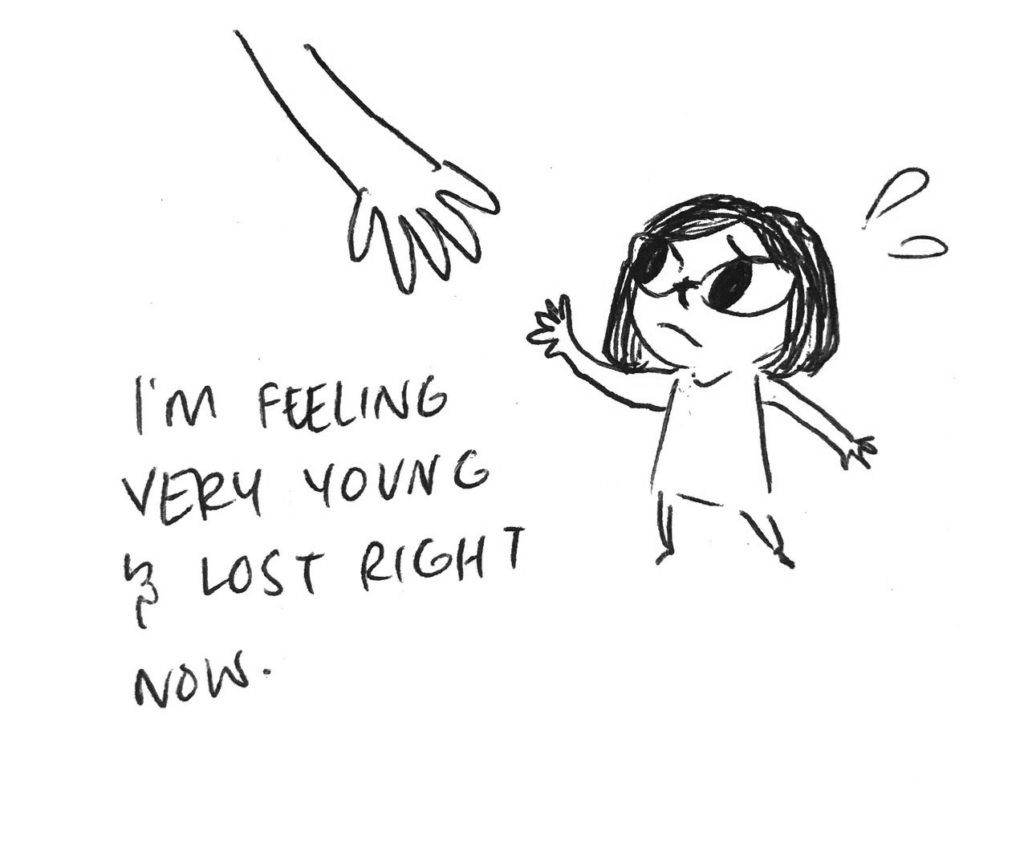
How has your work changed (no doubt lots have dried up but maybe something new has emerged)?
I was actually pushing for a lot of live events and in-person illustrating before the pandemic! Then we all had to stay home, so I switched back to remote work REAL quick! Fortunately, alongside my live work, I’ve been working remotely for many years, so it wasn’t a huge transition.
I’ve learned how to scribe virtually, which opens up many possibilities.
My amazing visual community came to the rescue with phone calls, Zoom tests, and resources.
Not travelling to events also eases the intensity that comes with live graphic recording, which is nice.
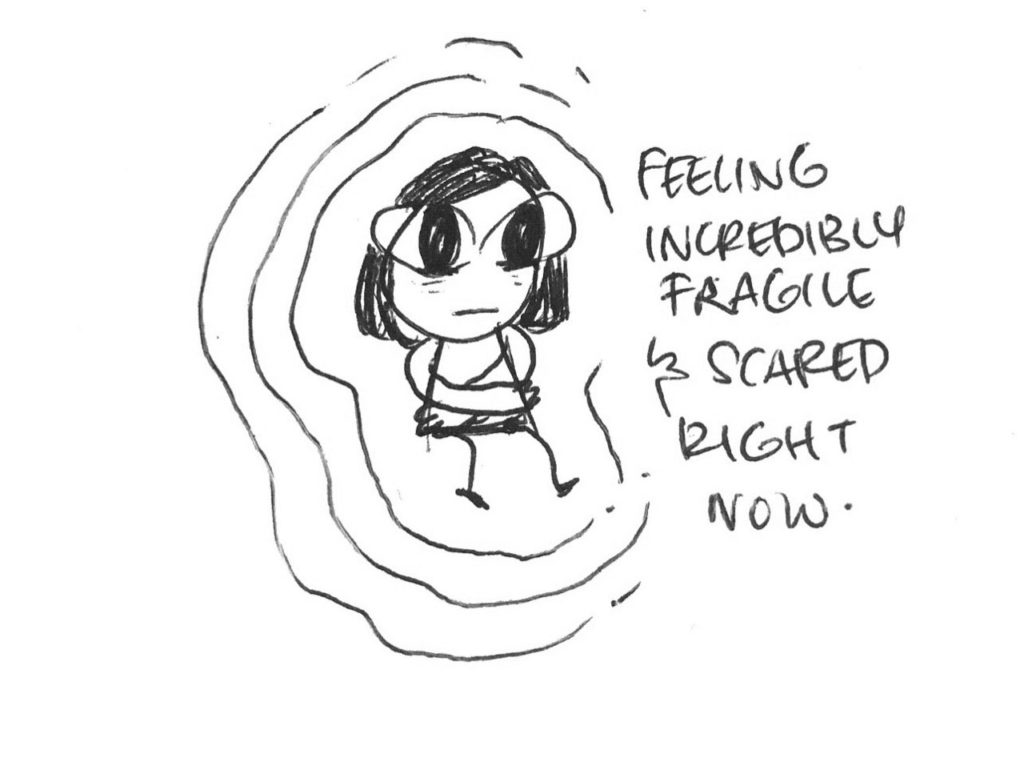
If visualisation is helping you personally in any way during this challenging time?
Absolutely. When I was trying to manage my emotions, it helped to draw them. Seeing my feelings reduced their enormity, and helped the unknown become known. I also started drawing what I hope to feel and see in the future, and that has helped me keep a positive headspace.
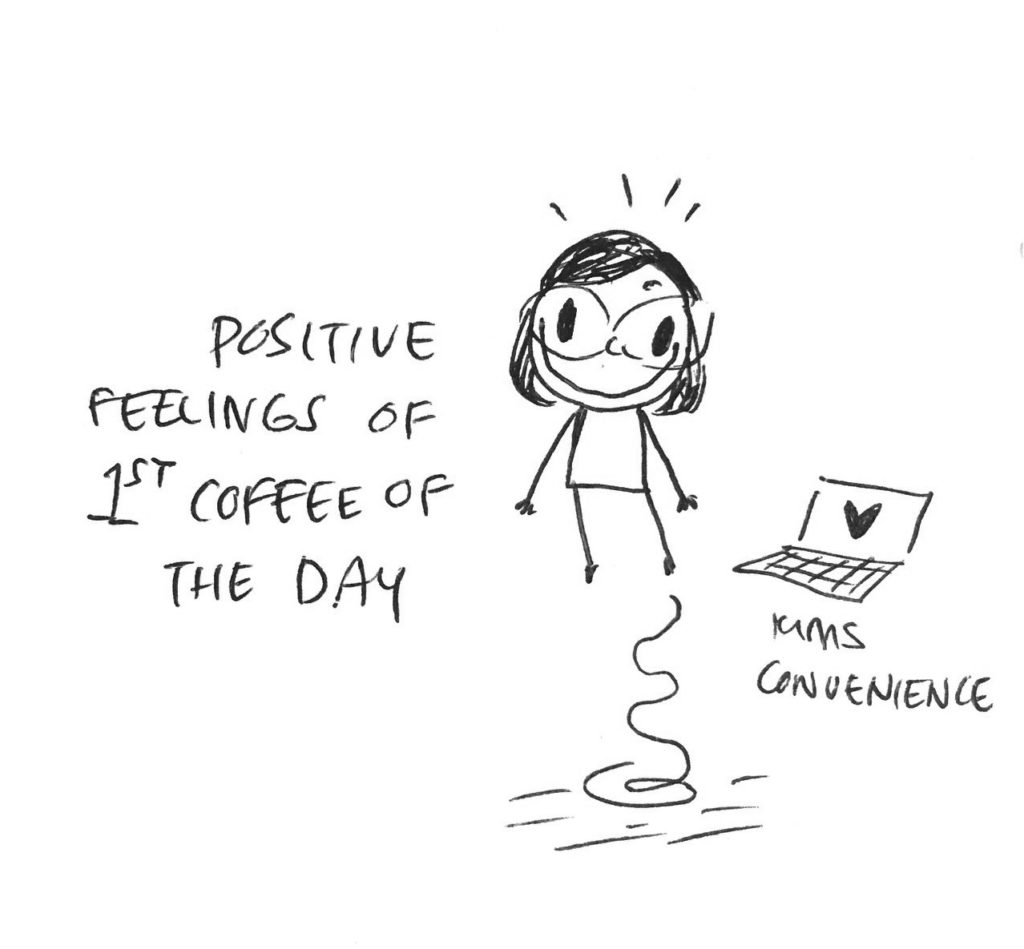

The article was written by Natalia Tsygankova. Natalia has always loved words and talking to people. She has put that passion to good use and has been sharing people’s stories in the community radio, TV and print media for the last 10 years. Natalia is also a big fan of true storytelling events and regularly volunteers at the most famous one – The Moth, interviewing the winner. You can hear her own story of moving to Australia from Russia in 1999 here. Natalia believes that everyone has a story – So what’s yours? Contact her today to share your story.


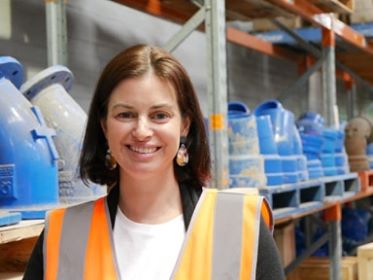
Innovation Manager at TasWater
I struggled in my role to penetrate in a creative way into the workplace. I was asked to come in and engage and innovate and it was a challenge.
So firstly, I wanted to be able to communicate with people in a better way and spark some enthusiasm. At our company, where things are run traditionally, we have a lot of documents, text and templates. But a large contingent of our workplace is field-based operators, people who don’t respond well to templates, instructions and thick manuals.
I find if I communicate in a more creative way, people then start thinking and interacting differently which results in better innovation.
Secondly, I wanted to bring visuals into our documentation. We are an organisation of strategies, visions and big documents that are often hard to read. Even before I came to the course I’d been trying to convert heavy text into visuals by presenting it in a more bite-size and aesthetically pleasing way, to make it more digestible for our customers or operation guys who don’t want to read a big document.
Generally, I wanted to find out more about graphic facilitation. I had seen graphic recording at a conference a few years prior and felt that we definitely needed more of that in our business.
I had seen bikablo online and that style appealed to me. I was curious about it. I stumbled across Visual Friends when I was searching for the right people who taught this technique. Unfortunately, there were no trainers in Tasmania and I would have had to travel to Australia to attend the training.
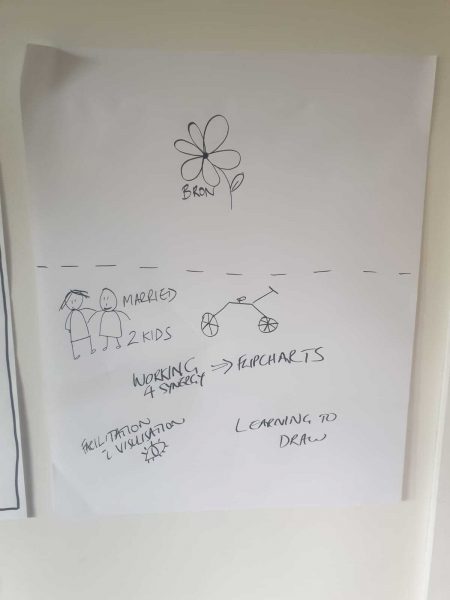

Beginning of Training Day 1
The online option was a much better option for me. Otherwise it would have meant three days (with travel) away from my family and taking time off work.
I had two very enjoyable days, they went really fast. There was plenty of time to ask questions or to go over things. There was a great balance between having time on and off screen. It didn’t feel like you had to sit and listen, there was always something to do. It worked really well, and I felt that I got so much out of the two days. I can’t think of anything I would change or suggest.
It was a bit overwhelming.
I remember looking at the first visual I did at the beginning of day one, how hesitant I was to put pen to paper. And then you look at your final poster, it’s like a totally different person drew it. It was hard to believe I achieved it in only two days.
I felt quite empowered having done the course and being able to actually produce something that big and with that much impact in only two days was amazing.
It’s not a complicated technical concept, it’s stripping it right back and making it as simple as possible. It’s a bit like Coco Channel’s advice, “put three things on and then take one thing off”.

End of Training Day 2
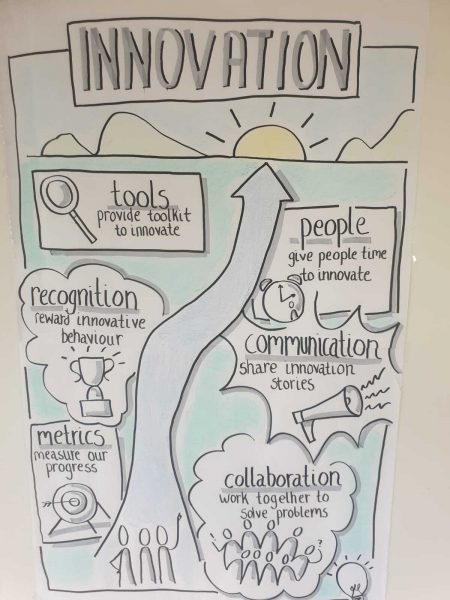
Yes! I have already done three posters for people at work in the first week after the training. A poster for diversity and inclusiveness, one for strategy, and a visual summary of top tips for working from home.
My CFO wrote to me the other day upon seeing some drawings, “This is incredible”.
I’m looking forward to bringing more visuals into my work. I’m so glad I have found Visual Friends.

The article was written by Natalia Tsygankova. Natalia has always loved words and talking to people. She has put that passion to good use and has been sharing people’s stories in the community radio, TV and print media for the last 10 years. Natalia is also a big fan of true storytelling events and regularly volunteers at the most famous one – The Moth, interviewing the winner. You can hear her own story of moving to Australia from Russia in 1999 here. Natalia believes that everyone has a story – So what’s yours? Contact her today to share your story.


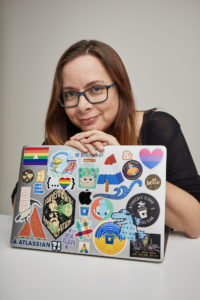
Content Designer Manager | Writer | Technical Communicator at an Australian Global Organisation, Leader in IT Service Desk and Project Management Software
![]() I’m so thankful I have come along to the Visual Friends course, it has really shifted and changed things for me.
I’m so thankful I have come along to the Visual Friends course, it has really shifted and changed things for me.
A hug was not something Linette would have expected going into that meeting. After all, all she did was draw.
But that’s exactly what happened. The team manager was so thrilled at the breakthrough Linette created through her visuals, that she leaped across the room and gave her a big hug.
The product development team of 25 had been working on the project for nine months. There was a lot of conceptual and abstract data that was difficult to wrap up into a neat, mutually exclusive and collectively exhaustive process they were trying to create. The team was stuck. Linette visualised all the elements on paper and immediately everything became clear. Her visuals became the key that unlocked the project puzzle.
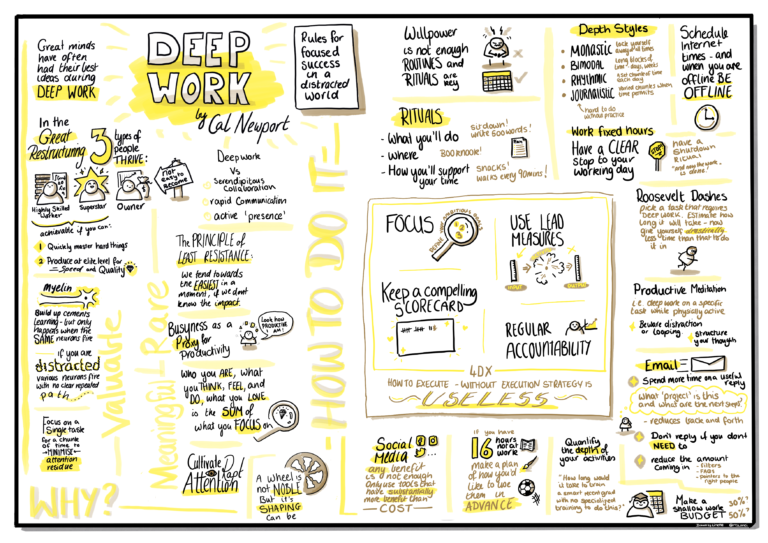

Visual summary of Cal Newport’s
book ‘Deep Work’.
Funnily enough, Linette never considered herself visual. “I was interested in art and did a bit at school as an elective. But I was discouraged from pursuing it. There was very much a feeling that anything visual was only for people who couldn’t do science. Science was more important.”
After school Linette completed a degree in Industrial Design which further cemented her belief that drawing was not her strength. “Other students were doing these brilliant sketches and my little stick figure next to their 3D rendering would look awful. That confirmed in my mind that I didn’t have great visual skills.”
So for years the only drawing Linette did was doodling while talking on the phone. Until she heard a colleague, Ben Crothers, the author of “Presto Sketching”, give a talk about sketchnoting.
“Wow! I wish I could learn that skill, “ thought Linette. She had seen visual facilitators doing this work and thought it was amazing. A colleague mentioned bikablo. “And I thought, what on Earth does bikablo mean? What is this?”.
A few people recommended the course as a great starting point in the area of visualisation, something really useful, and Linette was in. She persuaded her manager to send her on a course, “but I was wondering, actually, how and if I’d be able to apply it in my day to day life and work.”
Linette did the two-day bikablo fundamentals course in March, 2019 with Danny Low and Marc Hundleby.

Sketch of Sarah Richards’s ‘Content Design’ talk that Linette attended
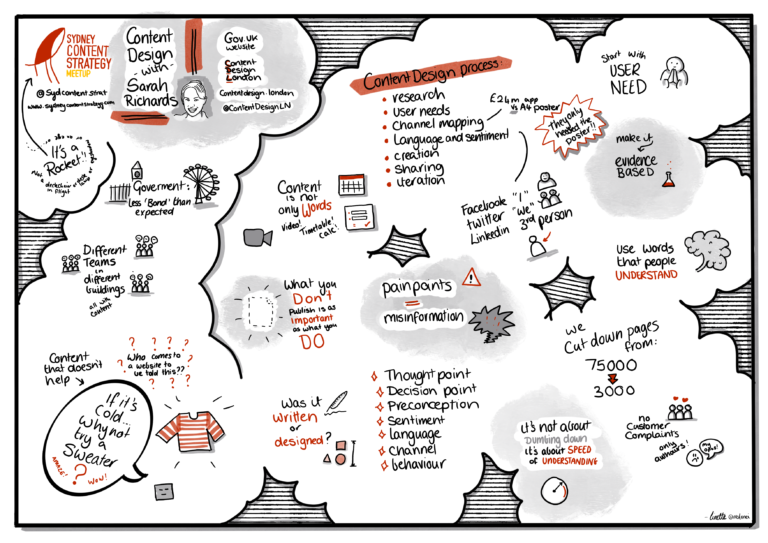
“I found the experience excellent. It was reassuring to see other people in the room saying, “Well, I’m not good at drawing, I find stick figures challenging. It made me feel very safe.”
The step-by-step process allowed Linette to tackle one mini skill at a time without sliding into the familiar mindset of “I can’t draw.”“Going through the steps, each time I thought, yes, I can do this and yes, I can do that too.It was challenging to put up our creations on the walls and, at first, I was scared that my work would be the worst. But I was delighted to see that we all did different things, we interpreted things differently and absolutely everyone had something really impressive. It was amazing to see the skill developing around the room.”
Back at work, initially Linette was apprehensive to use the skills she’d just learnt. She began practising by taking visual notes during meetings without showing it to anyone. Once, at a strategy meeting, she decided to share her visuals with the team, quite pleased with what she had sketched.
“The manager looked and said, “Wow! They are fantastic”, shared them with the product leadership team, got the same excited response and my drawings were published on the strategy internal webpage, for everyone in my area to see. I did have to run away and tidy it up a bit, because it was sketched on lined paper without proper markers.”
From then on, Linette became known as the visual person at work. “People would ask me, “Oh, we are trying to get this idea across, can you draw a thing?” She also began to regularly take visual notes during monthly strategy meetings and they were always very well received. “I feel it’s certainly because of these visuals that people higher up in the organisation knew a bit more about who I was, people who otherwise might have not met me or interacted with me.”
And that’s how Linette ended up in the meeting that we started our story with. “Essentially, all I did was listen to the team and sketched what they were saying. They had all the information but the challenge was communicating all that complex conceptual data visually.”
Unfortunately we can’t share the drawings or the details of the project here, but we can say that thanks to Linette’s drawings helped communicate the process to a lot of people. In addition, visualisation, as a part of the process, was recommended to the next team that was working on a similar project.
Since then Linette has done a few other things. Visual Friends training gave her the courage to enrol and complete a nature illustration course. Practising visualisation by creating visual summaries of non-fiction books led to her being approached by a publisher who saw one such drawing on instagram. It is now going to be used as an illustration in a future book. Linette is also mastering the Apple Pencil and virtual scribing. Her morning ritual during the covid-19 isolation is drawing virtual zoom backgrounds.
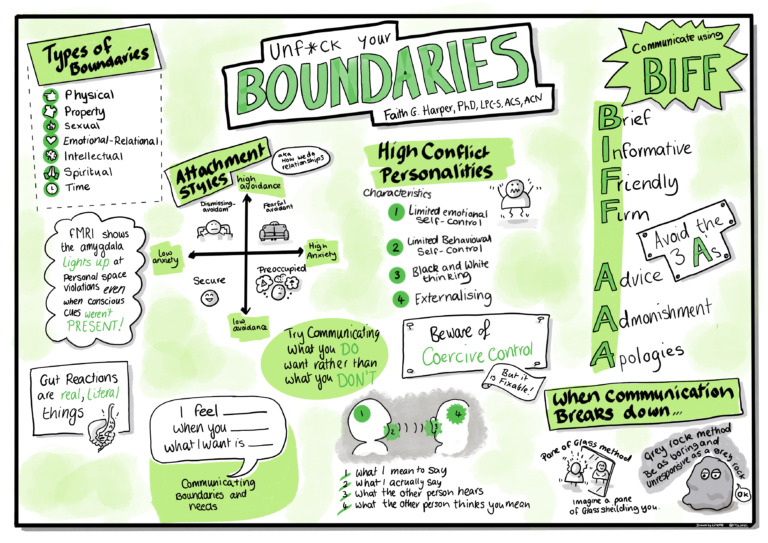

I found that training with Visual Friends helped me unlock my creativity. I genuinely think that I would not have had the confidence to do all that, had it not been for doing the bikablo course.” But the highlight so far is still that first strategy meeting, when Linette’s notes were used as a visual for the whole product strategy.
“Even now people refer back to that illustration to explain our focus and goals. That was the moment when I switched from feeling like my notes were a creative ‘indulgence’ to seeing how much they could help others.
I”m so thankful I have come along to the Visual Friends course, it has really shifted and changed things for me.”

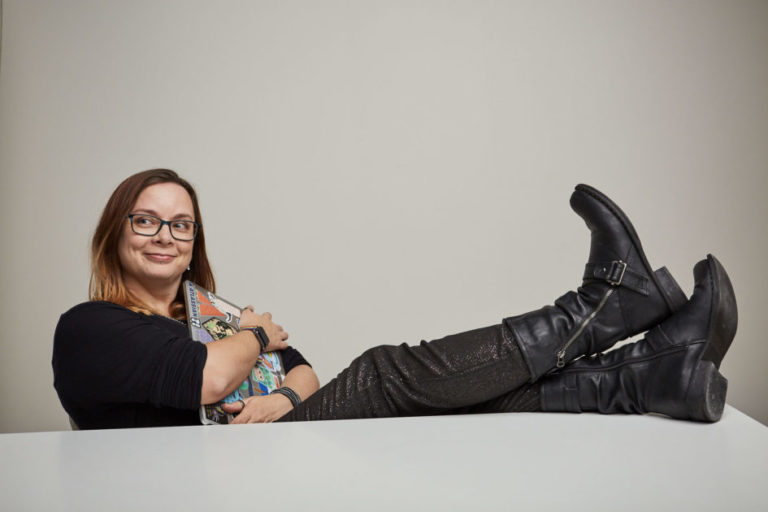

The article was written by Natalia Tsygankova. Natalia has always loved words and talking to people. She has put that passion to good use and has been sharing people’s stories in the community radio, TV and print media for the last 10 years. Natalia is also a big fan of true storytelling events and regularly volunteers at the most famous one – The Moth, interviewing the winner. You can hear her own story of moving to Australia from Russia in 1999 here. Natalia believes that everyone has a story – So what’s yours? Contact her today to share your story.


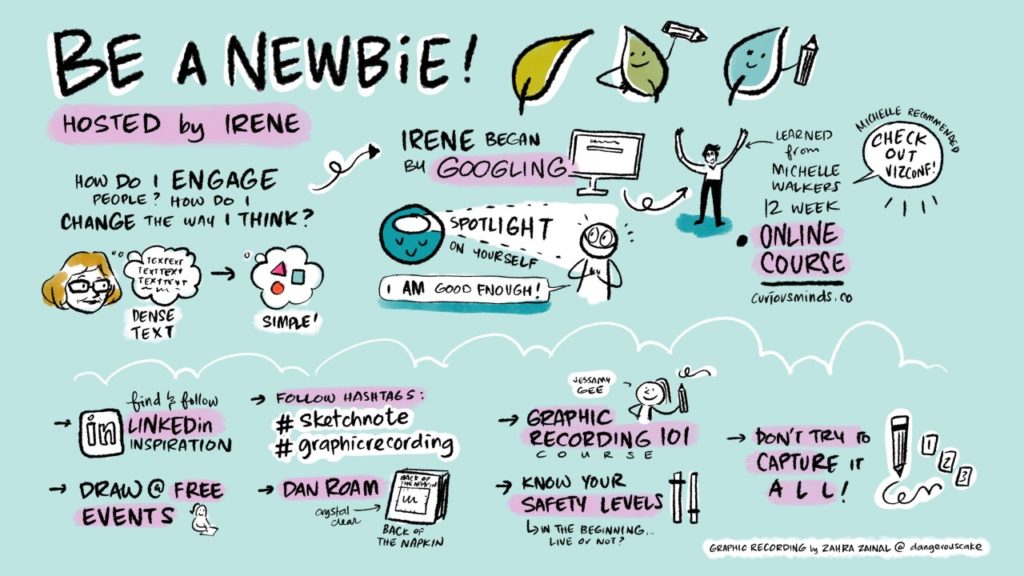
During the VizConf 2019 OpenSpace planning, when participants advertised their sessions and everyone voted for the ones they were interested in, collaboratively creating the daily agenda, a petite woman in her 50s came to the front. She smiled and said she wanted to lead a session on “How to be a newbie”. My heart sunk. I thought that after ‘serious’ topics like “Lettering for Lefties”, “Visualisation in Education”, and “Digital Scribing”, that we already had on the board, no one would want to hear her speak.
How wrong was I. Nearly every hand in the room shot up? “Being a newbie” was one of our most popular sessions that day. We talked about how hard it is to start something new and what resources, tools and tricks one can employ to help visualisation progress.
Plato said, “The beginning is the most important part of the work”. It is also often the hardest.
With the first month of 2020 over, have you begun taking steps towards being a more confident visual practitioner? Whether you are a professional or a complete amateur, becoming better at any aspect of visualisation begins with the single first step.
So, here are just a few “newbie” suggestions to help you start building your
visualisation muscles this year.
And the best bit? You can start making plans for 2020 visually. Grab a piece of paper, a marker and draw your visualisation journey for 2020.
If you need help – join our free video training here or ask for a visual career coaching session with Marcel here.
All you need to do is simply begin, and before you know it, you’ll no longer be a newbie.

The article was written by Natalia Tsygankova. Natalia has always loved words and talking to people. She has put that passion to good use and has been sharing people’s stories in the community radio, TV and print media for the last 10 years. Natalia is also a big fan of true storytelling events and regularly volunteers at the most famous one – The Moth, interviewing the winner. You can hear her own story of moving to Australia from Russia in 1999 here. Natalia believes that everyone has a story – So what’s yours? Contact her today to share your story.



Service Designer | Cartoonist | Writer
How are you doing now?
We were fine at our place — some cabin fever and some dread about what happens next for us professionally, when wed feel it would be OK to send our daughter back to kinder, etc. But generally all right.
I’m concerned for people with pre-existing conditions that might be badly affected by the virus, and frustrated by poor comms (by the government) on the problem, and the reactions of libertarian/right-wing types to what’s happening (which were predictable).
How has your work changed?
Nothing has really changed yet, but the economic slowdown is yet to hit. The GFC kicked off in 2008 but affected the next couple of years’ worth of projects and led to lean times. Ultimately it forced me to think harder about my career and what I wanted to be doing, so there was a tiny bit of good to be found in it as well.
In the short term, I am doing work right now that’s directly related to COVID — because clients I already had have come back to me for help in explaining what’s happening visually.
I’m not sold on “remote scribing” as something super useful to clients, but using those scribes as the basis for more finished material that does help them will be good.
Also, I’m not sure if the timing is just coincidental, but I have a few book projects which are maybe moving forward slightly right now. Fingers crossed.

Is visualisation helping you personally in any way during this challenging time?
Well, I think in pictures, so yes. My wife (also a cartoonist) and I are looking at now as the time to do some whiteboard plotting to work out how we’re going to keep our careers alive for the next few years, and hopefully aim for more and more interesting work and clients as we do. We did this a few years ago and it led me into HCD/service design.
And this time we’ll be using some HCD tools as well, which are often also nice and visual. Things like ‘Desirable/Viable/Feasible’.
I’m trying to narrow down my projects and be smart about how I spend my time — so more prep/research/writing right now, but if one of these projects is picked up (eg: by a publisher) I’ll suddenly be doing lots of drawing!
Thank you, for sharing, David.
You can connect with David on LinkedIn, follow him on socials or enquire about the courses he runs like Drawing for Story and Narrative Visualisation for Designers. All the details are on his website.
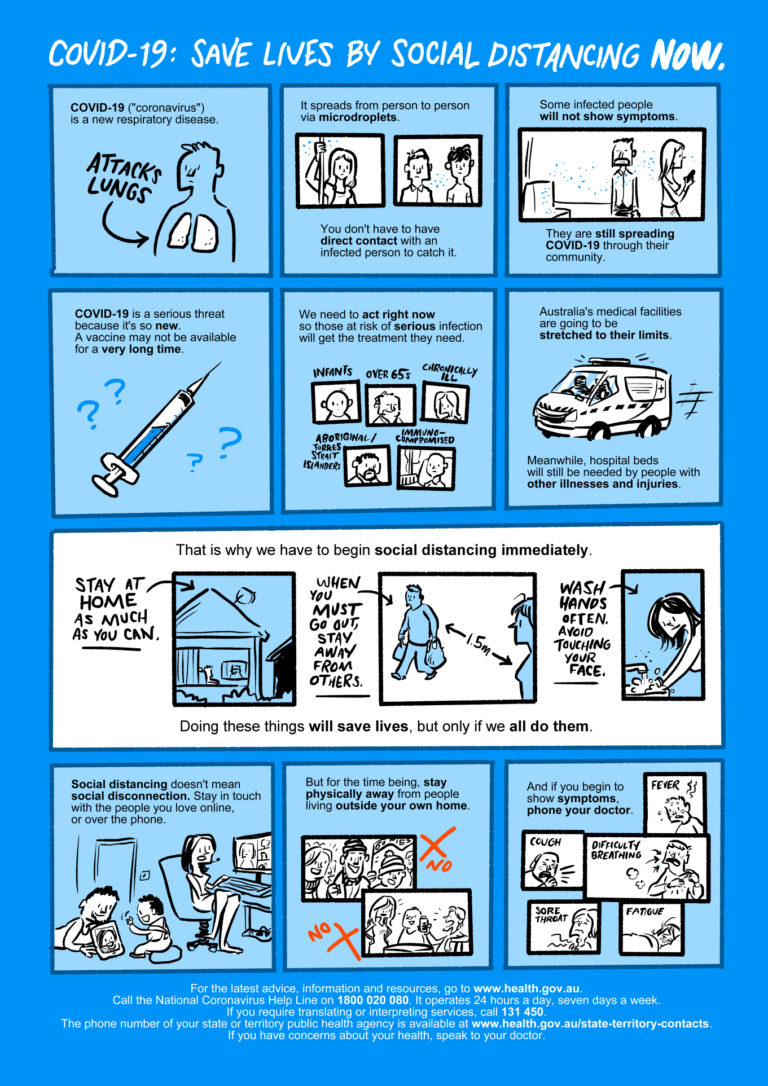
David Blumenstein created this to help explain the COVID-19 disease in his local area (Melbourne, Aus). It’s adapted from government health info (Department of Health, 16 Mar 2020). If you think it would help you, you’re welcome to use it; download A4, poster and socmed versions here.
Medical knowledge and government policy on this disease changes daily; please don’t make use of this if it’s out of date (note the date of publication at top). he’ll try to keep it up to date if possible, and make edits to this post to indicate so.

The article was written by Natalia Tsygankova. Natalia has always loved words and talking to people. She has put that passion to good use and has been sharing people’s stories in the community radio, TV and print media for the last 10 years. Natalia is also a big fan of true storytelling events and regularly volunteers at the most famous one – The Moth, interviewing the winner. You can hear her own story of moving to Australia from Russia in 1999 here. Natalia believes that everyone has a story – So what’s yours? Contact her today to share your story.


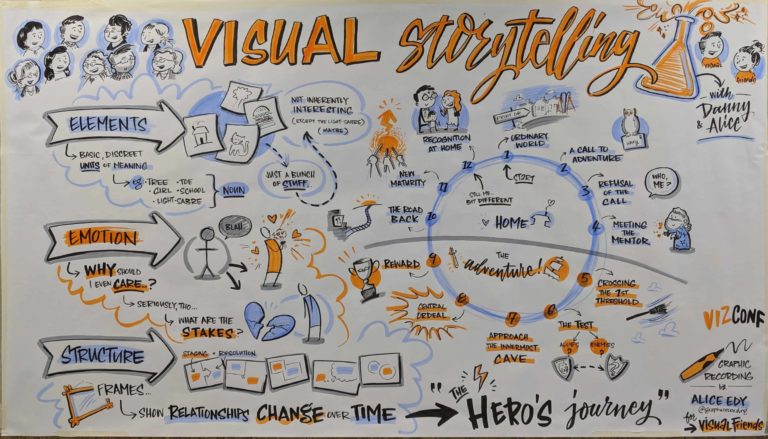
Last weekend my family and I put together the very first furniture items in our new home after moving overseas – an Ikea table and four chairs. After eating on boxes for a week, we couldn’t wait. The four of us, including a 6-year-old, a 10-year-old and two adults in their 40s assembled everything in under an hour using only one allen key and a set of drawings.
If you look around your home, chances are, you’ll spot at least one Ikea item you assembled yourself. Stressful as it can be, (i.e. where the heck does this go??), imagine if you had to deal with a long list of instructions instead of simple drawings.
It’s a well-known fact that most of us prefer to consume information visually. According to the study republished by Forbes, “91% of consumers now prefer visual and interactive content over traditional media.”
But did you also know that people can follow instructions 323% better when visuals are used? That’s because our brain is so much better at dealing with images than text. According to MIT researchers, the human brain is capable of processing an image in as little as 13 milliseconds. The blink of an eye takes about 300 milliseconds.
Though nowadays, visuals alone won’t do the trick anymore. It’s more about what you do with them, which is where visual storytelling comes in.
As overused as this term might seem, it’s not just a buzzword. Using a series of drawings to create a narrative for a specific purpose – to record, to communicate, to engage, to influence – has been around for centuries.
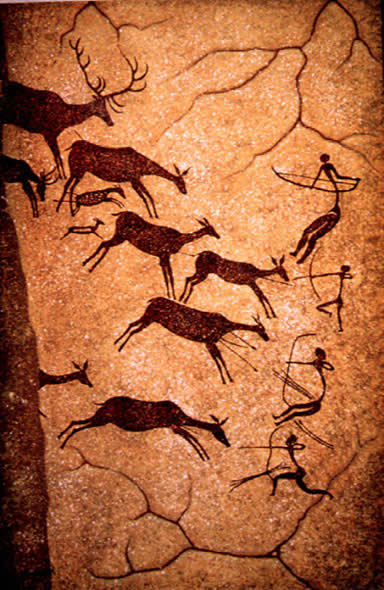

It is still the most powerful way to put ideas into the world today.
Visual storytelling has become a trend for the majority of brands since 2016. Visual narratives with an accent on relevance and emotions are now part of every big brand’s marketing.
In organisations, visual storytelling is increasingly used as a way to support transparency and mutual understanding of systems and processes, for example, development of ‘customer journeys’, large scale ‘strategic visualisations’ and even ‘design thinking’.
Telling curated stories visually through photos, videos, comics and infographics (the most shared content on the web) is currently the most direct way to connect with your customers, your team or your stakeholders.
In a nutshell, visually storytelling seems easy – pick your content, line up visuals and off you go.
But to do it well, to do it effectively, you need to understand the specific storytelling techniques and develop a different set of skills.
That’s why the Global Bikablo Team created the advanced bikablo training covering popular topics like ‘Visual Storytelling’ and “Graphic Scribing’, which began its roll out world-wide in 2020.
During the two days of training the students, who have already learnt the basic visualisation principles during the bikablo fundamentals course, learn how to transform complex subjects into lively picture stories. With the bikablo emotions figures, large-format layout techniques and visual dramatic composition, students are taught to convey necessary messages in a clear, but more emotional and lively way.
Our Brisbane based trainer Danny Low attended the Global bikablo train-the-trainer course last year in Germany and is now the only certified instructor to teach advanced bikablo in Australia and NZ. “The course, with the focus on visual storytelling for business, allows you to take your visual skills to the next level. We teach people the theory behind the visual storytelling, how to create visual hierarchy, the most effective ways to layout and present the content on paper. This is the deep knowledge that has been packaged into a time-effective workshop on the hottest visualisation topics.”
Last year at VizConf, (Australia’s premier and only conference for visual practitioners), we trialled the advanced class with a small group of participants.
Sujith Ramachandra, a Senior Consultant at Radically, and one of our enthusiastic students had an opportunity to attend the session. “The pace of the course, the balance of theory and practice was fantastic and I came out with a lot to think about and a boost of energy and confidence. Visualization with clarity and awareness of the power of storytelling is a game-changer.”
Watch out for the advanced bikablo classes on our website or contact us to arrange an in-house session (if your team has already completed bikablo fundamentals).

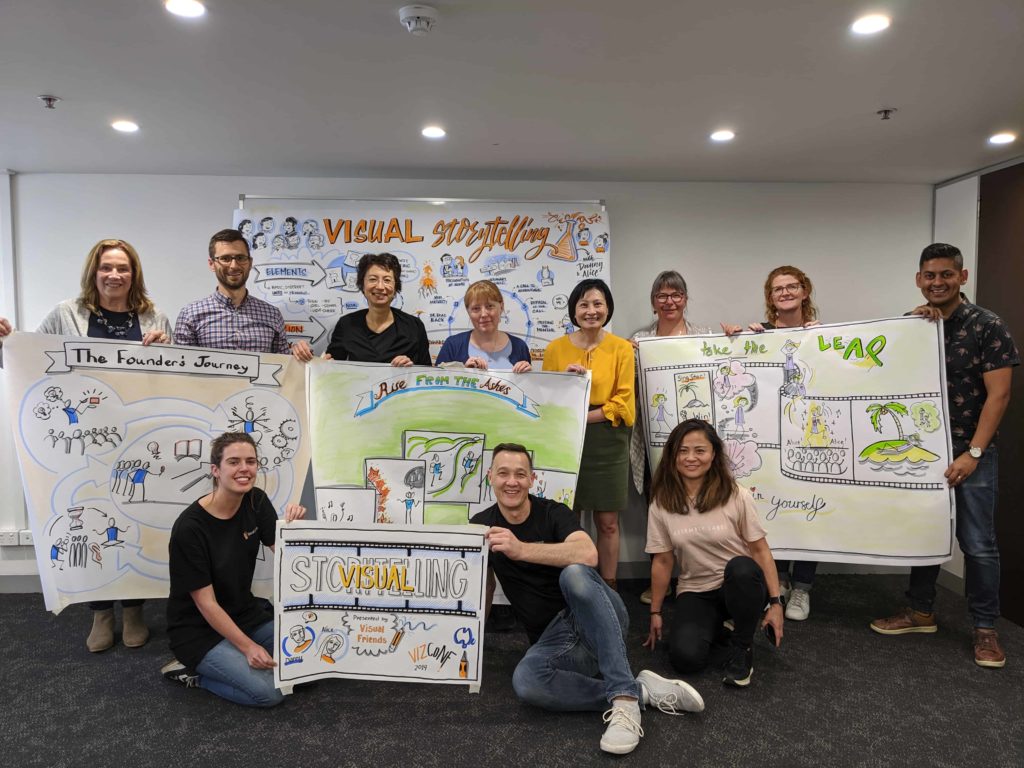

The article was written by Natalia Tsygankova. Natalia has always loved words and talking to people. She has put that passion to good use and has been sharing people’s stories in the community radio, TV and print media for the last 10 years. Natalia is also a big fan of true storytelling events and regularly volunteers at the most famous one – The Moth, interviewing the winner. You can hear her own story of moving to Australia from Russia in 1999 here. Natalia believes that everyone has a story – So what’s yours? Contact her today to share your story.



Primary school teacher and now a part-time graphic scribe
![]() Anyone can learn visualisation. Once you learn basic icons, fill your page and get a grasp on shading, the world is your oyster.
Anyone can learn visualisation. Once you learn basic icons, fill your page and get a grasp on shading, the world is your oyster.
Matt loves his work. “I’ve always been creative and being a primary school teacher provides a creative outlet.”
Now that Matt knows bikablo®, his work has become even more interesting. And not just for Matt but also for his colleagues.
Like many of our students, Matt saw bikablo® in action when someone was scribing at a meeting. Matt always enjoyed taking notes, but this seemed to be next level. Curious, he began researching visualisation skills and came across Visual Friends.
“I saw what people can do, it’s quite inspiring. I thought it would be great to take my knowledge to the next level.”
With the support of his principal, who understood the great benefit of bringing such applicable skill to the school, Matt enrolled in bikablo® fundamentals training.
Teachers can be fussy students, but he found the course really useful. “It was hands on from the word go which is the best way to learn. I learnt to use the space in a smart way and it gave me confidence to work through a page.”
As a teacher, Matt also appreciated the research behind visualisation. “It engages all areas of a learner.” What also appealed was how easy it was to learn this skill and how much you could achieve once you understood the basic principles.
“It’s not that complicated. Once you learn basic icons, fill your page and get a grasp on shading, the world is your oyster. You can then go on and develop your own style.”
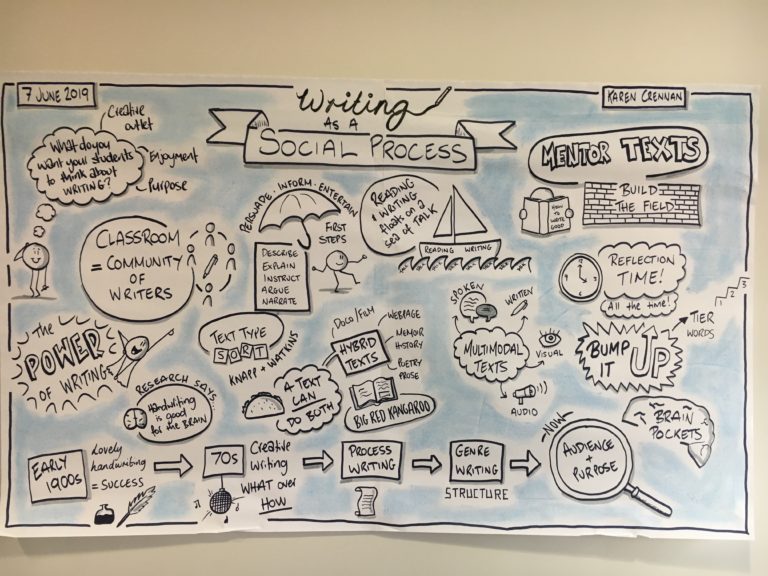

Writing as a Social Process
Matt Handley
Matt feels that’s an important part of learning visualisation or any other subject for that matter – to build on your skills and develop your way of doing things.
“I think the key is to be flexible and just draw things that stand out to you. It’s about making it your own, whether it’s using your own font or your favourite picture. It doesn’t have to be perfect. And of course, the more you practice, the better you get.”
That’s exactly what Matt has been doing.
Since completing the course, he has been giving back to his workplace, creating posters, helping with presentations and meetings. Matt’s three-meter canvas describing school’s self-improvement project journey was displayed at the school library and generated some interesting discussions.
“People have been looking at it and talking about it. Some say they wouldn’t be able to do something like that, but I assure them that with a bit of practice everyone can do it.”
Following his original interest, Matt also took his notetaking to the next level and tried live scribing at school events.
“It was stressful, but it also taught me to focus on the main points instead of trying to capture every word. Those key points are the ones that will trigger people’s memories and will facilitate the conversation.”
Matt is pleased with the feedback he’s received so far. “People comment on how easy it is to read and follow two hours worth of talking on one page.”

Journey of Learning – Matt Handley
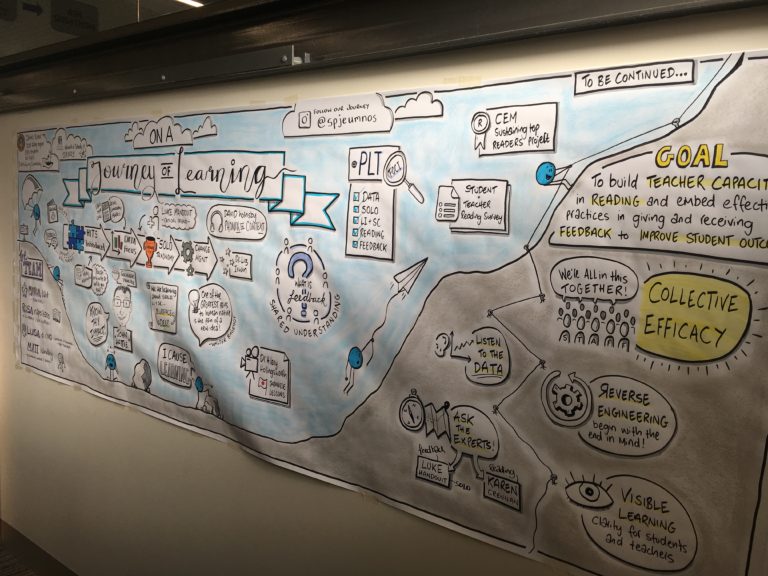
The skills Matt has leant with Visual Friends are definitely making a difference at his workplace. Visualisation is now seeping in the way the school does things.
“In terms of transcribing and professional development, it’s been more than beneficial for our staff and school. Our principal is pleased with how it has turned out.”
Matt is pretty happy too. He has developed a long-term interest in visualisation and added a unique skill to his toolbox that will have a positive effect on his career.
“It’s definitely something I see myself using in the future, wherever my career takes me. It’s a great tool you can share with others.”
P.S. Since we’ve interviewed Matt, he has started his own business working as a graphic scribe in his spare time. You can find him on instagram @_highlyvisual.

The article was written by Natalia Tsygankova. Natalia has always loved words and talking to people. She has put that passion to good use and has been sharing people’s stories in the community radio, TV and print media for the last 10 years. Natalia is also a big fan of true storytelling events and regularly volunteers at the most famous one – The Moth, interviewing the winner. You can hear her own story of moving to Australia from Russia in 1999 here. Natalia believes that everyone has a story – So what’s yours? Contact her today to share your story.

